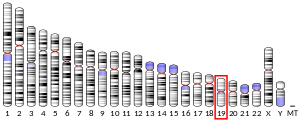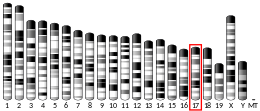Neurogenic locus notch homolog protein 3 (Notch 3) is a protein that in humans is encoded by the NOTCH3 gene.[5][6]
Function
editThis gene encodes the third discovered human homologue of the Drosophila melanogaster type I membrane protein notch. In Drosophila, notch interaction with its cell-bound ligands (delta, serrate) establishes an intercellular signalling pathway that plays a key role in neural development. Homologues of the notch-ligands have also been identified in human, but precise interactions between these ligands and the human notch homologues remains to be determined.
Pathology
editMutations in NOTCH3 have been identified as the underlying cause of cerebral autosomal dominant arteriopathy with subcortical infarcts and leukoencephalopathy (CADASIL).[6] Mutations in NOTCH3 have also been identified in families with Alzheimer's disease.[7] Adult Notch3 knock-out mice show incomplete neuronal maturation in the spinal cord dorsal horn, resulting in permanently increased nociceptive sensitivity.[8] Mutations in NOTCH3 are associated to lateral meningocele syndrome.[9]
Pharmaceutical target
editNotch3 is being investigated as a target for anti-cancer drugs, as it is overexpressed in several types of cancers.[10] Early clinical trials of Pfizer's PF-06650808, an anti-Notch3 antibody linked to a cytotoxic drug, showed efficacy against solid tumors.[11]
References
edit- ^ a b c GRCh38: Ensembl release 89: ENSG00000074181 – Ensembl, May 2017
- ^ a b c GRCm38: Ensembl release 89: ENSMUSG00000038146 – Ensembl, May 2017
- ^ "Human PubMed Reference:". National Center for Biotechnology Information, U.S. National Library of Medicine.
- ^ "Mouse PubMed Reference:". National Center for Biotechnology Information, U.S. National Library of Medicine.
- ^ Sugaya K, Fukagawa T, Matsumoto K, Mita K, Takahashi E, Ando A, Inoko H, Ikemura T (September 15, 1994). "Three genes in the human MHC class III region near the junction with the class II: gene for receptor of advanced glycosylation end products, PBX2 homeobox gene and a notch homolog, human counterpart of mouse mammary tumor gene int-3". Genomics. 23 (2): 408–19. doi:10.1006/geno.1994.1517. PMID 7835890.
- ^ a b "Entrez Gene: NOTCH3 Notch homolog 3 (Drosophila)".
- ^ Guerreiro RJ, Lohmann E, Kinsella E, Brás JM, Luu N, Gurunlian N, Dursun B, Bilgic B, Santana I, Hanagasi H, Gurvit H, Gibbs JR, Oliveira C, Emre M, Singleton A (2012). "Exome sequencing reveals an unexpected genetic cause of disease: NOTCH3 mutation in a Turkish family with Alzheimer's disease". Neurobiol. Aging. 33 (5): 1008.e17–23. doi:10.1016/j.neurobiolaging.2011.10.009. PMC 3306507. PMID 22153900.
- ^ Rusanescu G, Mao J (2014). "Notch3 is necessary for neuronal differentiation and maturation in the adult spinal cord". J. Cell. Mol. Med. 18 (10): 2103–16. doi:10.1111/jcmm.12362. PMC 4244024. PMID 25164209.
- ^ Gripp KW, Robbins KM, Sobreira NL, Witmer PD, Bird LM, Avela K, Makitie O, Alves D, Hogue JS, Zackai EH, Doheny KF, Stabley DL, Sol-Church K (2014). "Truncating mutations in the last exon of NOTCH3 cause lateral meningocele syndrome". Am. J. Med. Genet. A. 167A (2): 271–81. doi:10.1002/ajmg.a.36863. PMC 5589071. PMID 25394726.
- ^ Purow B (2012). "Notch Inhibition as a Promising New Approach to Cancer Therapy". Notch Signaling in Embryology and Cancer. Advances in Experimental Medicine and Biology. Vol. 727. pp. 305–319. doi:10.1007/978-1-4614-0899-4_23. ISBN 978-1-4614-0898-7. PMC 3361718. PMID 22399357.
- ^ "Pfizer Oncology: ADC Development Overview (2016) » ADC Review".
Further reading
edit- Lewis J (1996). "Neurogenic genes and vertebrate neurogenesis". Curr. Opin. Neurobiol. 6 (1): 3–10. doi:10.1016/S0959-4388(96)80002-X. PMID 8794055. S2CID 2921624.
- Joutel A, Tournier-Lasserve E (2002). "[Molecular basis and physiopathogenic mechanisms of CADASIL: a model of small vessel diseases of the brain]". J. Soc. Biol. 196 (1): 109–15. doi:10.1051/jbio/2002196010109. PMID 12134625. S2CID 86151374.
- Guidetti D, Casali B, Mazzei RL, Dotti MT (2006). "Cerebral autosomal dominant arteriopathy with subcortical infarcts and leukoencephalopathy". Clin. Exp. Hypertens. 28 (3–4): 271–7. doi:10.1080/10641960600549223. PMID 16833034. S2CID 360190.
- Beleil OM, Mickey MR, Terasaki PI (1972). "Comparison of male and female kidney transplant survival rates". Transplantation. 13 (5): 493–500. doi:10.1097/00007890-197205000-00008. PMID 4557798. S2CID 32855236.
- Larsson C, Lardelli M, White I, Lendahl U (1994). "The human NOTCH1, 2, and 3 genes are located at chromosome positions 9q34, 1p13-p11, and 19p13.2-p13.1 in regions of neoplasia-associated translocation". Genomics. 24 (2): 253–8. doi:10.1006/geno.1994.1613. PMID 7698746.
- Tournier-Lasserve E, Joutel A, Melki J, Weissenbach J, Lathrop GM, Chabriat H, Mas JL, Cabanis EA, Baudrimont M, Maciazek J (1993). "Cerebral autosomal dominant arteriopathy with subcortical infarcts and leukoencephalopathy maps to chromosome 19q12". Nat. Genet. 3 (3): 256–9. doi:10.1038/ng0393-256. PMID 8485581. S2CID 13031278.
- Joutel A, Corpechot C, Ducros A, Vahedi K, Chabriat H, Mouton P, Alamowitch S, Domenga V, Cécillion M, Marechal E, Maciazek J, Vayssiere C, Cruaud C, Cabanis EA, Ruchoux MM, Weissenbach J, Bach JF, Bousser MG, Tournier-Lasserve E (1996). "Notch3 mutations in CADASIL, a hereditary adult-onset condition causing stroke and dementia". Nature. 383 (6602): 707–10. Bibcode:1996Natur.383..707J. doi:10.1038/383707a0. PMID 8878478. S2CID 4351873.
- Joutel A, Vahedi K, Corpechot C, Troesch A, Chabriat H, Vayssière C, Cruaud C, Maciazek J, Weissenbach J, Bousser MG, Bach JF, Tournier-Lasserve E (1997). "Strong clustering and stereotyped nature of Notch3 mutations in CADASIL patients". Lancet. 350 (9090): 1511–5. doi:10.1016/S0140-6736(97)08083-5. PMID 9388399. S2CID 38044421.
- Gray GE, Mann RS, Mitsiadis E, Henrique D, Carcangiu ML, Banks A, Leiman J, Ward D, Ish-Horowitz D, Artavanis-Tsakonas S (1999). "Human ligands of the Notch receptor". Am. J. Pathol. 154 (3): 785–94. doi:10.1016/S0002-9440(10)65325-4. PMC 1866435. PMID 10079256.
- Joutel A, Andreux F, Gaulis S, Domenga V, Cecillon M, Battail N, Piga N, Chapon F, Godfrain C, Tournier-Lasserve E (2000). "The ectodomain of the Notch3 receptor accumulates within the cerebrovasculature of CADASIL patients". J. Clin. Invest. 105 (5): 597–605. doi:10.1172/JCI8047. PMC 289174. PMID 10712431.
- Joutel A, Dodick DD, Parisi JE, Cecillon M, Tournier-Lasserve E, Bousser MG (2000). "De novo mutation in the Notch3 gene causing CADASIL". Ann. Neurol. 47 (3): 388–91. doi:10.1002/1531-8249(200003)47:3<388::AID-ANA19>3.0.CO;2-Q. PMID 10716263. S2CID 11532027.
- Joutel A, Chabriat H, Vahedi K, Domenga V, Vayssière C, Ruchoux MM, Lucas C, Leys D, Bousser MG, Tournier-Lasserve E (2000). "Splice site mutation causing a seven amino acid Notch3 in-frame deletion in CADASIL". Neurology. 54 (9): 1874–5. doi:10.1212/wnl.54.9.1874. PMID 10802807. S2CID 19374887.
- Shimizu K, Chiba S, Saito T, Kumano K, Hirai H (2000). "Physical interaction of Delta1, Jagged1, and Jagged2 with Notch1 and Notch3 receptors". Biochem. Biophys. Res. Commun. 276 (1): 385–9. doi:10.1006/bbrc.2000.3469. PMID 11006133.
- Wu L, Aster JC, Blacklow SC, Lake R, Artavanis-Tsakonas S, Griffin JD (2000). "MAML1, a human homologue of Drosophila mastermind, is a transcriptional co-activator for NOTCH receptors". Nat. Genet. 26 (4): 484–9. doi:10.1038/82644. PMID 11101851. S2CID 23335042.
- Beatus P, Lundkvist J, Oberg C, Pedersen K, Lendahl U (2001). "The origin of the ankyrin repeat region in Notch intracellular domains is critical for regulation of HES promoter activity". Mech. Dev. 104 (1–2): 3–20. doi:10.1016/S0925-4773(01)00373-2. PMID 11404076. S2CID 9526831.
- Saxena MT, Schroeter EH, Mumm JS, Kopan R (2001). "Murine notch homologs (N1-4) undergo presenilin-dependent proteolysis". J. Biol. Chem. 276 (43): 40268–73. doi:10.1074/jbc.M107234200. PMID 11518718.
- Oliveri RL, Muglia M, De Stefano N, Mazzei R, Labate A, Conforti FL, Patitucci A, Gabriele AL, Tagarelli G, Magariello A, Zappia M, Gambardella A, Federico A, Quattrone A (2001). "A novel mutation in the Notch3 gene in an Italian family with cerebral autosomal dominant arteriopathy with subcortical infarcts and leukoencephalopathy: genetic and magnetic resonance spectroscopic findings". Arch. Neurol. 58 (9): 1418–22. doi:10.1001/archneur.58.9.1418. PMID 11559313.
- Dichgans M, Herzog J, Gasser T (2001). "NOTCH3 mutation involving three cysteine residues in a family with typical CADASIL". Neurology. 57 (9): 1714–7. doi:10.1212/wnl.57.9.1714. PMID 11706120. S2CID 21180235.
External links
edit- NOTCH3+protein,+human at the U.S. National Library of Medicine Medical Subject Headings (MeSH)





